 |
 |
||||||||
 |
 |
||||||||
|
|||||||||
| Price $169.00 with Free shipping within the continental USA |
Information and unique products for Dogs, Cats, Rabbits and Backyard Chickens
Showing posts with label CHICKEN COOP. Show all posts
Showing posts with label CHICKEN COOP. Show all posts
Wednesday, March 11, 2015
Another Rabbit Huch To Be proud Of
Tuesday, March 10, 2015
Wooden Rabbit House and Chicken Coop
|
 |
 |
|
 |
 |
|
|
Wednesday, January 21, 2015
Using Straw And Hay In A Backyard Chicken Coop
Using Straw And Hay In A Backyard Chicken Coop
You might ask why we buy both — what’s the difference, after all? They look similar and both come tied up in bales — but hay and straw are two very different types of harvested material, each with a very different purpose on a farm.

Hay Let’s start with hay. Hay is primarily a livestock feed. There are various different types of hay available such as timothy, alfalfa, etc. but hay is generally grasses, and also some grains, leaves and legumes that have been harvested, dried and baled for use as animal fodder (or feed) before the seeds have formed (the formation of the seeds lowers hay’s nutritional value)
.
Horses, cows, sheep, and goats all eat hay, especially in the winter months when there is no fresh grass available to graze. Smaller animals such as rabbits and guinea pigs also eat hay. Hay is usually a shade of light green and smells good – like a sunny field on a warm summer day.
Prices for hay depend on where you live, the time of year and the supply of hay available. Right now in our area, hay is selling for nearly $9/square bale. Round bales are also available, at far more economical prices, for larger herds of livestock.
Straw Straw is primarily livestock bedding. Straw is a by-product of the harvest, usually the stalks and stems of the cereal grains or grasses such as oats, barley, rye or wheat, which are harvested after the plants are dead, so straw is far drier and doesn’t smell nearly as good — although I think it does still have a nice, albeit it more faint, farm-y smell! Occasionally there will be some kernels left at the tips of the stalks (the chickens love to eat those!), but straw is mostly hollow stems. Although goats can eat straw, there isn’t as much nutritional value in it as there is in hay.
Straw is far less expensive than hay in our area, selling for under $4/square bale.

So logically, we use straw and hay for
their intended purposes. Since hay is more nutritious, but more
expensive, we buy hay solely for the horses to eat.
Since straw is
cheaper, dried and therefore less likely to mold or attract moisture, we
buy straw for the backyard chicken coop and nesting boxes. Being
hollow, straw also provides more of a cushion for the eggs in the
nesting boxes and for the chickens to hop off the roosts onto. Because
the hollow tubes retain warm air, straw is also an excellent way to keep
your coop warmer in the winter.
Stacking straw bales along the inside walls
and allowing for a nice deep layer on the floor in the winter is an
inexpensive way to insulate your coop. Filling your nesting boxes with
straw can help prevent frozen eggs.

Some say that straw can attract mites to your coop. I don’t agree. I have been using straw in our coop in warm, humid Virginia (optimal mite breeding ground!) for more than five years and never had any problem whatsoever. Mites and lice feast on blood and skin tissue, not straw. They are not going to live inside straw tubes for very long, if at all. I do sprinkle food-grade diatomaceous earth on the floor of our coop and in the nesting boxes as a natural way to kill parasites and also use lots of dried and fresh herbs in the coop which help repel them. Bottom line, straw is a far better choice for coop bedding than hay for us both because of its price and far lower moisture content.
So that’s why we buy both straw and hay. Hay for the horses to eat and straw for the chicken coop and nesting boxes.
I do recommend using straw in your backyard chicken coop, but if you choose to use hay, for economical or logistic/convenience, just be sure to check it frequently and remove any wet or damp hay to prevent mold or mildew from building up in your coop litter.
http://www.backyardpoultrymag.com/straw-hay-backyard-chicken-coop/
by Lisa Steele
January 15, 2015
..
Saturday, December 13, 2014
Refresh a Dirty Chicken Coop with these Easy Green Tips
"Fresh
Eggs Daily" is author Lisa Steele's guide to raising healthy chickens
naturally, which includes feeding them a diet of herbs, flowers, and
greens.
Cover Courtesy St. Lynn's Press
Learn to treat your flock to a diet rich in a variety of herbs, greens, and flowers with Fresh Eggs Daily (St. Lynn’s Press, 2013). Lisa Steele offers dozens of simple, intelligent, and easy green tips for “going natural” that help you avoid common ailments that plague many backyard flocks. This excerpt from “In the Winter” features two recipes for refreshing and cleaning a chicken coop.
You can purchase this book from the Capper’s Farmer store: Fresh Eggs Daily.
Refresh a Dirty Chicken Coop with these Easy Green Tips
I have developed an all-natural refreshing spray for chicken coops that combines the rodent-repelling and insecticide properties of mint with soothing lavender in a white vinegar base (for both disinfecting and antibacterial qualities). Easy and inexpensive to make, a bottle stored in your coop and used any time your coop needs a bit of a refresh will help keep your coop sanitized and rodent free.You can also substitute vodka for the white vinegar in the following recipes. Why use vodka for cleaning? Vodka is another fine natural cleanser. It not only repels insects, it actually kills them. It is antibacterial and kills mold and mildew. As an added benefit, vodka is odorless, unlike white vinegar, which has a distinctive smell.
Lavender Mint Coop Refresh Spray
Handful of fresh mintHandful of fresh lavender leaves and/or bud
Bottle of white vinegar (or inexpensive vodka)
2 one-pint canning jars
Spray bottle
Divide the herbs between two canning jars, crushing them a bit with your fingers as you add each sprig to release the essential oils. Add white vinegar or vodka to each jar to completely cover, leaving at least 1/4 inch headroom in each jar. Screw on the lids and then set the jars in your pantry or on the kitchen counter to age. Shake the jars every few days to mix the contents.
The mixture will start to turn a greenish-brown color and smell fragrant in a week or two, indicating that the spray is ready to use. Strain the contents into a spray bottle. Spray in your coop as needed to keep it smelling fresh.
For Cleaning a Chicken Coop, Follow These Easy Green Tips
While a quick refresh results in a fragrant coop, take care that you are not merely masking any true odors that should be attended to. Any whiff of ammonia should be cause for a thorough cleaning. Chicken droppings emit ammonia and the fumes can irritate your hens’ eyes and mucous membranes. Many chicken keepers will tend to reach for the bleach as a coop cleaner, but mixing ammonia and bleach, as you may know, can result in toxic fumes. A far better alternative is this natural orange peel and white vinegar coop cleaner.
White
vinegar, as mentioned above, is a natural disinfectant with
antibacterial properties. It kills mold and is an ant repellent. Caution: Although apple cider vinegar has wonderful health benefits, which will be discussed later in the book, it should never be
used for cleaning, because it will attract fruit flies.
My coop cleaner includes orange peels. Citrus oil is a natural insect repellent and proven solvent, making it perfect for scrubbing your roosting bars. I add cinnamon sticks to the cleaner because cinnamon oil kills mosquito larvae.
Mosquitoes can spread fowl pox, a disease that causes black spots on hens’ combs. I also add vanilla beans to repel flies, mosquitoes and other insects. As in the preceding recipe, vodka can be substituted for the vinegar in this recipe if you wish.
2 cinnamon sticks
2 vanilla beans
Bottle of white vinegar (or inexpensive vodka)
2 one-pint canning jars
Spray bottle
Peel the citrus and divide the peels between two canning jars. Break the cinnamon sticks in half and add to the jars. Slit each vanilla bean and add to the jars. Pour enough white vinegar or vodka into each jar to completely cover the peels, leaving at least 1/4 inch headroom in each jar. Screw on the lids and then set the jars in your pantry or on the kitchen counter to age. Shake the jars every few days to mix the contents.
The mixture will start to turn an orangish-tan color and smell fragrant in a week or two, indicating that the spray is ready to use. Strain the contents into a spray bottle to use full strength for scrubbing roosts or nesting boxes, or mix with water to scrub the coop floor and walls. The cinnamon stick and vanilla bean can be reused for a second batch, but use fresh citrus peels. (This cleaner also makes a wonderful all-natural non-chemical kitchen cleaner.
Reprinted with permission from Fresh Eggs Daily: Raising Happy, Healthy Chicks…Naturally by Lisa Steele and published by St. Lynn’s Press, 2013. Buy this book from our store: Fresh Eggs Daily.
My coop cleaner includes orange peels. Citrus oil is a natural insect repellent and proven solvent, making it perfect for scrubbing your roosting bars. I add cinnamon sticks to the cleaner because cinnamon oil kills mosquito larvae.
Mosquitoes can spread fowl pox, a disease that causes black spots on hens’ combs. I also add vanilla beans to repel flies, mosquitoes and other insects. As in the preceding recipe, vodka can be substituted for the vinegar in this recipe if you wish.
Orange Peel White Vinegar Coop Cleaner
4 oranges (or 6 limes, 5 lemons, 2 grapefruit — or a mix)2 cinnamon sticks
2 vanilla beans
Bottle of white vinegar (or inexpensive vodka)
2 one-pint canning jars
Spray bottle
Peel the citrus and divide the peels between two canning jars. Break the cinnamon sticks in half and add to the jars. Slit each vanilla bean and add to the jars. Pour enough white vinegar or vodka into each jar to completely cover the peels, leaving at least 1/4 inch headroom in each jar. Screw on the lids and then set the jars in your pantry or on the kitchen counter to age. Shake the jars every few days to mix the contents.
The mixture will start to turn an orangish-tan color and smell fragrant in a week or two, indicating that the spray is ready to use. Strain the contents into a spray bottle to use full strength for scrubbing roosts or nesting boxes, or mix with water to scrub the coop floor and walls. The cinnamon stick and vanilla bean can be reused for a second batch, but use fresh citrus peels. (This cleaner also makes a wonderful all-natural non-chemical kitchen cleaner.
Reprinted with permission from Fresh Eggs Daily: Raising Happy, Healthy Chicks…Naturally by Lisa Steele and published by St. Lynn’s Press, 2013. Buy this book from our store: Fresh Eggs Daily.
Friday, November 7, 2014
Caution - Using Heat Lamps In The Coop
I hate the thought of a heat lamp in a dry coop. There's just way to
much risk of fire.
Also if you get a bad winter storm and the power gets knocked out for a couple days your chickens may freeze.
A cheap way to help your chickens out in the winter is to use a large heavy plastic tote with a lid. Cut a hole large enough for your chickens and they will use it on the coldest nights and stay nice and warm.
This method has been used in Canada for years. No heat lamps were needed, and there was not any frost bite either.
Also if you get a bad winter storm and the power gets knocked out for a couple days your chickens may freeze.
A cheap way to help your chickens out in the winter is to use a large heavy plastic tote with a lid. Cut a hole large enough for your chickens and they will use it on the coldest nights and stay nice and warm.
This method has been used in Canada for years. No heat lamps were needed, and there was not any frost bite either.
Tuesday, October 14, 2014
15 Accessories for Your Chicken Coop
Choosing from the many accessories available for your chicken coop can be overwhelming. Use this guide to determine what you need right away and what can be added to the wish list.
By Cory Hershberger , Hobby Farms Assistant Editor

No matter what your chicken coop might look like or what your end purpose in chicken-keeping might be, a number of accessories are available that can enhance your chicken-keeping experience, making it as easy and fun as possible, while keeping your beloved brood safe and healthy.
Basic Accessories
These coop accessories are essential to all coops, keeping your chickens fed and hydrated and providing them with adequate sleeping and egg-laying locations in their cozy home. Before you start thinking about fancier add-ons, make sure you incorporate these fundamental enhancements into your flock’s coop.
Nest Box
Because hens seek a secluded place to lay their eggs, nest boxes, complete with clean, dry bedding, are an essential feature of most chicken coops. David Frame, a Utah State University Extension poultry specialist, recommends placing the nest box (or nest boxes, depending on how many chickens you own) in darker areas to promote its usage. He also encourages poultry keepers to have a good amount of nest boxes accessible: “Even though the rule of thumb is one nest box to about five hens, I suggest having more nest boxes available than that to discourage overcrowding,” he says.
Roosting Bars
Most chicken breeds roost, or perch, to sleep at night. To enhance the chicken’s comfort, some keepers provide roosting bars for their birds to perch on throughout the night. It’s a good idea to include at least one bar per bird (or a bar long enough for multiple birds to perch on), and Frame recommends smoothing off the edges on the bars’ top surfaces to minimize potential foot discomfort.
Waterer
The most important element in a chicken’s diet is water, so ensure that clean, fresh water is available to your flock at all times to avoid issues with growth and egg production and to keep your birds healthy. Waterers come in an assortment of types and designs, such as a portable fountain-type drinker and a bell-type drinker that can be hooked up to a low-pressure water line.
“Always put in more waterers than you think you’ll need,” Frame says, as this can help accommodate shy chickens and allow for the availability of fresh water in the event of a spill or malfunction.
Feeder
Food is another vital ingredient for a healthy flock, and like waterers, feeders come in a variety of designs, including feeders that can be hung from the coop ceiling and bucket feeders that can store a few days’ worth of feed. Frame emphasizes that floor feeders need to have a lip deep enough to minimize feed spillage onto the coop floor. He adds that excess feed should be stored properly. “Always store unused feed in closed containers, such as Rubbermaid bins or covered plastic garbage containers,” he says.
Heater and Thermometer
If you plan to hatch and raise chicks, a heating element and a brooder thermometer are absolute necessities. Because chicks cannot produce enough energy to keep themselves warm (this is why mothers cover the chicks with their bodies), a heating element, such as a heat lamp, is essential to their survival. A brooder thermometer also allows you to monitor the actual temperature of the chicks’ habitat, raising or lowering the heat as needed.
Comfy Accessories
This category of accessories is for the chicken keeper who is willing to splurge a little on their coop for additional safety or ease of care. None of these add-ons is required for a healthy and productive flock, but they could make tending to your poultry much easier.
Waterer Upgrade (Heated and/or Continuous Flow)
In addition to the basic waterers mentioned above, additional designs can make providing water for your brood much easier. A waterer with a heated base will keep the water from freezing on cold days and nights, as will a continuous-flow design, which also keeps the water from becoming stagnant.
Wheels
Depending on the size of your coop, it might be possible to attach wheels to the frame and move it around the yard. As a side effect of their scratching and picking at the soil in search of bugs and plant material to eat, chickens aerate the ground under their feet while fertilizing it with their droppings. By moving the coop around your property, you can spread these benefits across your whole plot of land, minimizing potential destruction to your grass.
Electric Fencing
If you have a free-range flock, electric fencing is an excellent way to keep your birds contained while keeping them safe from predators. “In trials, we found [electric fencing] even discourages raccoons from entering,” Frame says. Electric fencing can be implemented in a number of ways, including a simple one- or two-wire system, electrified poultry netting, or hot wires added to existing fencing.
Edible Plants
You can supplement your chickens’ diet with edible plants, including spinach, lettuce, watermelon, cantaloupe and comfrey (which Frame notes is a particular favorite of many birds) to vary their diet and provide them with additional nutrient sources. Frame discourages the consumption of grass, however. “Grass clippings are hard to digest and may cause impaction, and folks often treat grass with herbicides and insecticides,” he says. For more information on chickens and edible garden plants, check out “Garden-variety Chickens” in the March/April 2013 issue of Hobby Farms.
Boredom Busters
To provide a little variety in your flock’s diet and keep them busy, you can either purchase or make an edible block treat. These treats usually contain an array of ingredients, including various grains and meals along with some all-important grit to help with digestion. As your chickens break apart the block treats little by little, their natural scratching and pecking instincts are encouraged by the treats, keeping them healthy and entertained all at once. Frame also notes that chickens love to scratch and pick at alfalfa, especially in the winter.
Upscale Accessories
These add-ons are for chicken keepers who want to take their coop to the next level, and they range from gadgets designed to help protect and watch over a flock to embellishments and decorations aimed at beautifying coops from the bottom up.
Coop Décor
Chicken coops don’t have to just be functional; they can also add to your farm’s overall style with keeping your flock safe and sound. Tiffany Kirchner-Dixon, photographer and blogger at The Fancy Farmgirl, keeps function in mind with her coop’s decorative touches, such as the stylish wall hooks she uses to hold egg buckets and feed scoops; the galvanized, lidded buckets where she stores extra feed; and the coop’s predominant feature—a classic chandelier that keeps her hens laying year-round.
Kirchner-Dixon advises keepers to meet their chickens’ basic needs before adding decoration, but she points out that even the basics can be stylish. “Even creature comforts can be pretty, like the vintage ladder I use for the chickens to roost, or the vintage windows and shutters I added to the coop for ventilation,” she says. She suggests keeping decorative items either on the outside of the coop or up high in the coop itself and to keep small, shiny items away from the coop entirely.
Green Roof
To fully maximize the space that your chicken coop occupies, consider building a coop with a green roof. With a little extra construction, you can grow plants right on top of your chickens’ cozy home. It does require extra planning to ensure that the coop can hold the soil and plant weight, as well as a waterproofing membrane to keep moisture from sinking into the structure itself. Incorporating a slight slant to the coop’s green roof (or any coop roof) also allows you to collect rainwater in a rain barrel to help with your flock’s water needs or water plants around the farm.
Automatic Door Closer
For free-range chickens, installing an automatic coop-door closer will make locking your chickens in the coop at night a cinch. These coop doors are set on a timer to open in the morning and let your flock out to roam and subsequently close at night to keep the birds locked in the coop. Despite their convenience, Frame advises chicken keepers to perform frequent checks to ensure that the door closer is working properly. “[Automatic door closers] require frequent monitoring to make sure they don’t close birds out if they malfunction,” he says.
Solar-powered LED Light
If you have a long-standing problem with predators, such as raccoons, coyotes or foxes, encroaching on your chicken coop at night, consider a solar-powered LED light to help keep your flock safe. These lights gather power during the day and flash a small red light from dusk until dawn, which predators perceive as a threat, causing them to keep their distance from the coop.
Video Camera
For an illuminating look at the goings-on of your flock, try installing a video camera in the coop for the inside scoop on your chickens’ behavior. Frame points out that this can be very entertaining, of course, but it can also be informative, too. “If you really want to be enlightened about what goes on in the coop at night, add infrared [to your camera],” he says. “This may help [you] get an understanding of rodent and other varmint challenges.”
http://www.hobbyfarms.com/livestock-and-pets/chicken-coop-accessories.aspx?utm_source=SilverpopMailing&utm_medium=email&utm_campaign=HF-2014-10-14_RB%20%281%29&
Hen House and Hutch Design at top of this post is by Purina Mills
.
 .
...
Winter Lighting For Your Chickens

Egg production tapers off when hens don't catch enough rays, which explains why many flocks stop producing completely in winter.
A little mood lighting inside their coop, however, can help compensate for the shorter days. Just be sure to select bulbs that cast a warm glow—as the chandelier shown here does—since bluish-white light won't trigger laying.
http://www.thisoldhouse.com/toh/photos/0,,20712574_21354981,00.html
Tuesday, September 9, 2014
5 Ways to Make Coop-Cleaning Easier

Courtesy iStock/Thinkstock
Cut farm-chore corners without putting the health of your chickens at risk with one or more of these coop-cleaning techniques.
1. Hay
Although in Florida, where I live, many chicken coops have dirt floors, I like to cover the dirt with barn lime to dry the ground and kill bacteria, then add a layer of hay overtop to minimize health issues. Hay is easier to manage than straw and is clean and dust-free, unlike pine shavings. Plus, hay is economical and easy to obtain. Although you’ll need to change it out weekly, it can be dumped straight into the compost bin.
Diatomaceous earth is often used in coops to keep mites at bay, but I prefer barn lime. Poultry experts recommend against DE because it causes respiratory illness in chickens and is harmful to their lungs. Barn lime, on the other hand, is made of crushed limestone, or calcium carbonate, which aids in the formation of eggshells. Bear in mind, barn lime is different from hydrated lime; hydrated lime should not be used for animals.
To clean the coop, we rake the ground and move the old hay to the composting bin, then rebed with barn lime and fresh hay. We clean the coop every two weeks in hot, dry weather and once a week during the wet season. For a chicken coop of 100 chickens, it takes us about 1 hour to re-bed.
2. Dropping Boards
Chickens naturally head to the coop at night to roost, so you’ll typically find a hefty number of droppings waiting for you in the morning. Minimize your morning work by placing dropping boards under the roosts. Dropping boards are plastic trays or wooden boards that can easily be installed into your chicken coop by nailing, screwing or just placing them on the ground. You’ll need to measure your coop fit the appropriate size dropping boards. As an alternative, some chicken keepers build their coops with dropping pans, wooden boxes under the roost to aid in easy cleanup.
You can find manure scrapers on the market to clean the dropping boards, but a spare taping knife or spatula can be used instead. To clean, use the scraper to pull all the droppings into a bucket. Voila! You’ve cleaned the coop! Compost the manure and use it as a natural fertilizer in the garden.
3. Removable Roosts
Many coops are constructed with built-in roosts, but you can opt for removable ones for easier cleaning and disinfecting. Use undiluted distilled vinegar or Oxine, an animal-safe product effective against bacteria, fungi and viruses, for disinfecting the roosts and inside the coop.
4. Deep Litter Method
For colder climates, the deep litter method is a wonderful way to keep your coop warm and easy to manage. As the name implies, the deep litter method is a way to allow your litter to build up and compost over a period of time, from a couple months to a whole season. As the litter and manure composts in the pen, it provides warmth to the chickens. For the colder states, the litter can build up the entire winter. To start the deep litter method, sprinkle barn lime to help with odor and fly control. Top with 4 to 6 inches of pine shavings or hay. Every few weeks, stir the litter, adding more barn lime and fresh shavings or hay to the mix. For natural mite and lice control, you can mix in ash once a month.
5. Tarp Method
My friend Hope E. Tolda, owner of Fancy Feathers Farm, uses the tarp method on her farm and is able to clean 15 coops in less than 1½ hours. Lay a tarp on the coop floor and top with straw. When the straw needs to be changed, fold the tarp and dump the manure and straw into the compost pile. Pressure wash the tarp and disinfect it with vinegar or Oxine before rebedding the coop.
About the Author: Alexandra Douglas is the owner of Stellar Game Birds, Poultry, and Waterfowl and author of Coturnix Revolution (CreateSpace Independent Publishing, 2013). She graduated from Oregon State University in 2009, majoring in Animal Sciences with a Poultry and Prevet option. She specializes in quail and shares a diversified farm with her partner, Eric.
..
5 Steps to Get the Best Eggs Possible
Treating your layer hens to a little TLC will mean delicious, golden-yolked eggs for your morning breakfast.
Back in the days before my layer flock came to enliven life on our farm, I would have picked the egg for sure—or maybe the egg carton. After all, the runny, pale-yolked eggs I cooked came from cartons sold at the grocery store, not from any chickens that I could see. My perspective changed, however, when I brought home our first fuzzy chicks, watched them grow into gawky pullets and waited—and waited—with bated breath for our first farm-fresh eggs to magically appear.
I eventually learned that not only did you first need chickens to have eggs (obviously), but to start getting eggs, you also needed your pullets to reach about 20 weeks of age. And to get an ongoing supply of good eggs, your chickens needed the right food, clean nest boxes, sufficient daylight and more. In other words, because an egg’s quality reflects the care and management the hen receives, getting good eggs takes some work—and not just on the chicken’s part. Take it from anyone who has ever kept a layer flock, the delicious results are well worth the effort.
If you think fun chickens giving delectable eggs every day sounds like a recipe for hobby-farm happiness, our guide to getting good eggs will help you collect the right ingredients.
 Courtesy Wavebreak Media/Thinkstock |
What’s In an Egg?
Before we look at what should go into a laying chicken, let’s talk about what comes out. That amazing chicken egg has a protective, external, porous shell consisting mainly of calcium carbonate covered with an invisible protein barrier called the cuticle that shields the interior from bacterial contamination.
These structures, along with an inner membrane, surround a cushiony, cloudy albumen (the white), composed mostly of water and protein. The albumen in turn envelopes the nutrient-packed yolk, the egg’s main nucleus of protein, fatty acids, vitamins and minerals. On average, a chicken egg contains about six grams of protein and six grams of fat.
Provide the Basics: Food, Water, & Coop
Food
To keep its body functioning and to produce one of these self-contained, nutrient-rich units each day, it’s essential a laying hen receive a balanced diet with adequate levels of protein, carbohydrates, fat, vitamins and minerals.
For laying flocks older than 16 to 20 weeks, experts generally recommend a balanced layer ration containing 16- to 18-percent protein and approximately 3½-percent calcium to promote strong eggshells.
Many raisers also offer free-choice oyster shell for extra calcium in case their feed falls short of this important mineral. Calcium deficiency can result in thin-shelled eggs and leg problems. You may need to offer your birds the higher-protein feed during periods of peak egg production and when hot weather causes birds to eat less.
If you keep your flock confined, don’t forget to provide them with a source of insoluble grit to assist in grinding the feed in their gizzards. You’ll find oyster shell, grit, formulated layer rations and various types of feeders at your local feed store. Some even carry balanced, organic layer diets, if you prefer your flock dine on food free of antibiotics and grown in a sustainable fashion.
Chickens allowed to free-range pastures, orchards, gardens or other outdoor areas will consume a nutritious and diverse mix of insects, grains, berries, seeds and plants in addition to their formulated fare. Many chicken keepers treat their flocks to other goodies, too, from bread to surplus cow’s milk. However, a number of poultry experts advise against this practice.
"A lot of farmers try to save money by feeding scratch grains and household food scraps,” says Jacquie Jacob, PhD, poultry extension associate at the University of Kentucky College of Agriculture, Food and Environment. "This dilutes the nutrition of the laying feed and can result in shell weakness or cessation of production altogether.”
Water
Laying chickens also require a constant supply of fresh, clean water. Not only does a chicken’s body use this life-sustaining liquid for numerous physiological functions, but water also comprises more than half of an egg’s volume. You must ensure your birds have a reliable water source during both hot and dry periods and freezing weather or their egg production will suffer.
Coop (The 5 Steps)
Along with a balanced diet and ample water, your chickens need protection from the elements, predators and disease to stay alive and healthy—and thus keep laying eggs. A cold, wet chicken, for example, will be forced to spend its energy reserves trying to stay warm rather than on egg production. A sick or stressed chicken will often reduce its egg output or completely quit laying. And it goes without saying that a bird killed by fowl cholera or a coyote will not be giving you any more eggs—ever.
1) A Proper Coop
A snug, secure, well-built and properly ventilated chicken coop will offer your flock shelter from inclement weather, give your birds a predator-safe spot to roost at night, and discourage the presence of disease-carrying rodents and wild birds.
Outdoor access into a covered coop or pen gives the chickens a protected place to dust bathe, scratch for bugs and preen in the sunshine. However, not all raisers keep their birds cooped round-the-clock; many allow their flocks to free-range around the farm during the day, while others utilize pasture-based systems that incorporate mobile chicken tractors or moveable poultry netting.
Both confinement and free-range systems have their pros and cons, Jacob says. Free-ranging birds may have more room and increased opportunities to behave like chickens and forage for a varied, natural diet, but outdoor living does pose definite risks.
"Many people think that having chickens romping around a pasture is idyllic, but they can’t imagine all the threats the birds are exposed to, such as diseases and predators,” says Francine Bradley, PhD, an extension poultry specialist with the Department of Animal Sciences at the University of California, who recommends confining layer flocks. "If your birds are enclosed, you’ll also be able to quickly find the eggs. You can supply a clean nest box so the chicken lays there instead of hiding its nest somewhere or laying its eggs in a mud puddle. This increases your chances of getting clean eggs.”
2) Keep the Coop Clean
Whichever raising system you use, avoid crowding your chickens and keep their environment as clean and dry as possible.
Regularly layering fresh litter in houses, preventing mud formation in pens and raking up droppings will help prevent your birds from tracking feces and mud into their nest boxes and onto their eggs. Hygienic conditions promote healthier hens, as will paying attention to biosecurity issues, such as quarantine periods for new fowl and limiting visits to your farm from other chicken raisers.
"If a visit is necessary, the farmers should have showered before coming to the farm and should not wear clothing, including baseball caps, shoes and boots that they’ve worn anywhere near their own birds,” Jacob stresses.
3) Provide Nest Boxes
To get eggs—especially nice, clean, intact ones—you’ll need to persuade your chickens to lay where you want them to lay, not in some poopy corner of their coop or hidden in tall grass somewhere out in the back 40.
Bradley stresses providing plenty of covered nest boxes for your flock; one for every four hens. You can purchase easy-to-clean nest boxes from poultry supply companies or build your own from wood. Install the boxes about 2 feet off the floor and deeply layer each with clean, soft litter, such as non-toxic wood shavings, to provide cushioning for the eggs and to absorb droppings.
"You might want to tack a little cloth over part of the opening to make it secluded and dark. Chickens like this and it will help prevent egg eating,” Bradley says. "You’ll want to put a plastic or rubber egg in the box first to attract the chickens to the nest box.”
For birds allowed outside, Jacob suggests keeping them inside until later in the day so you won’t have to embark on an Easter egg hunt every morning.
Most chickens finish their egg-laying by 10 a.m. or so. Knowing exactly where your birds deposit their eggs will enable you to find and gather the eggs promptly, making it less likely for them to become broken and attract a hungry chicken’s attention.
"Egg eating is a very bad vice and one chicken can teach the others this habit,” Bradley says. "It’s best not to let the habit start to begin with.”
4) Set Up Lights
Light is another important factor that affects egg production and a good many neophyte chicken keepers have been left scratching their heads and wondering why their chickens quit laying as winter set in. (Note: Hens will also cease laying during molting periods.)
"Hens come into production with increasing hours of light per day and go out of production with decreasing hours of light per day,” Jacob explains. "A minimum of 14 hours of light per day is necessary to maintain egg production. Timers can be used so that the [artificial] lights don’t have to be on all day; they can come on before sunrise and/or stay on after sunset in order to maintain the required number of hours of light per day.”
5) Clean Eggs Well
Frequent egg collection coupled with clean, dry, uncrowded nest boxes and coops will go a long way toward keeping your flock’s eggs clean. Not only is a pristine, freshly laid egg a thing of beauty, but it can go right into a carton and into your fridge, no scrubbing required.
"If eggs are found clean, there’s no need to wash them since it would remove the bloom, or cuticle, which is the invisible, protective layer naturally found on eggs,” Jacob says.
But despite our best efforts, sometimes dirty eggs happen. With a small amount of dirt or droppings, you can:
- Dry clean the egg by buffing it off with some fine-grit sandpaper.
- Wet washing, although the normal procedure in commercial
operations, can result in bacteria being sucked into the egg if done
improperly (for example, in a cold bucket of water).
- Got some really filthy eggs? Toss them out to be on the safe side.
- As soon as you collect them, stash your fresh eggs small-side down in a dated egg carton in the refrigerator. Don’t store them with or near odorous foods like onions or fish. When cooking with raw eggs, be careful you don’t cross-contaminate other foods and always cook eggs thoroughly. Wash your hands well afterward with warm water and soap.
In fact, it’s a wonder more people don’t keep chickens, given that fresh-from-the-coop eggs look and taste so much better than store-bought. As Golson has discovered, the straightforward recipe for optimal egg production has changed little over the years.
"I have a favorite book, first published in 1895, called The Biggle Poultry Book, which gives advice for the ‘urban hennery,’” she says. "It used to be that most everyone had a few hens in their backyard to provide eggs for the table. The advice that worked then is just as good now: Provide a secure shelter, access to a yard and sunlight, good food, and keep it clean. That’s it!”
Get more egg and chicken-keeping help from HobbyFarms.com:
About the Author: Cherie Langlois is a former zookeeper and a freelance writer who has kept a variety of chicken breeds—and enjoyed dozens of fresh eggs!—on her Washington farm for over 17 years.
..
Friday, August 29, 2014
Voted #1 Pallet Made Chicken Coop
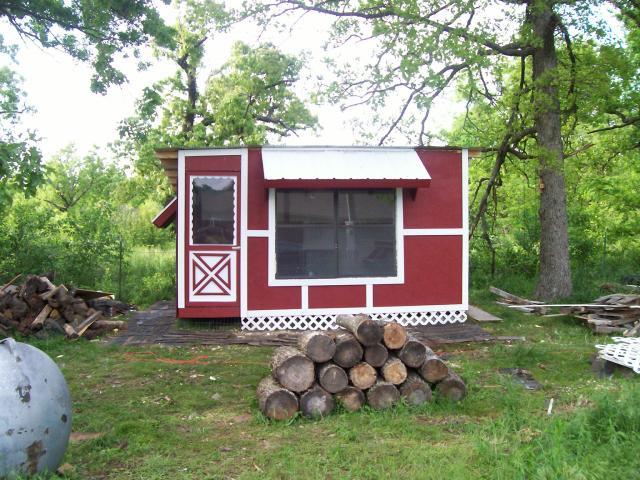
Pallet Palace
Chicks love it!
Thanks to all at BYC for advice and tips. Also thanks to BYC for the #1 vote in Coop Design Contest!
This
originally started out as a wood shed, so there are no early
construction pictures.
This was built using 22 standard oak
pallets. Making sure you use the same make of pallets is very helpful.
If one is different this makes putting up interior and exterior walls
very difficult.
- Back wall - 8 pallets = 8' x 16"
- Side walls - 4 pallets = 8' x 8'
- Front wall - 6 pallets = 8' x 16' (leaving opening for door)
Walls and Roof:
After you're all attached you can stand your wall up (another person helps here). It helps if bottom of wall is close to where it will be set so that when you stand it it is close to it's permanent position. Brace the wall by attaching 2x4's to sides and wedge in the ground until you're ready to attach side walls.
Repeat the steps for sides and front wall. Front wall is a little different being you're only attaching 6 skids and it will not reach side wall. this will be the opening for your door.
Once your walls are joined and standing you can start screwing them all together. This is where a level comes in handy. Get the back wall level as possible and attach side wall to it by screwing together or by 2x4 inside. Make sure if you set wall on the inside of the back wall, forming an L, you do the same on the opposite side.
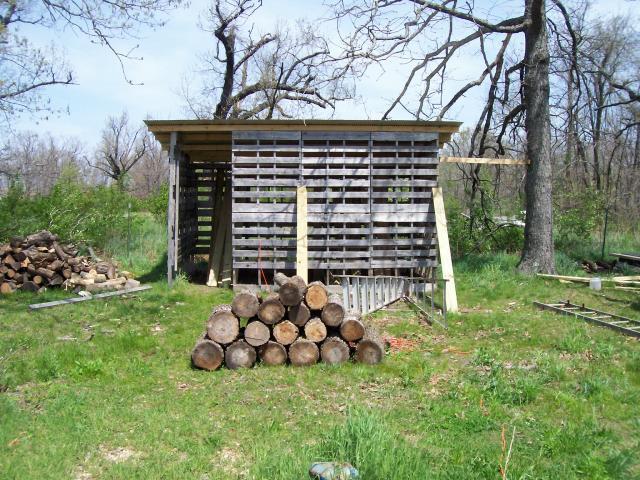
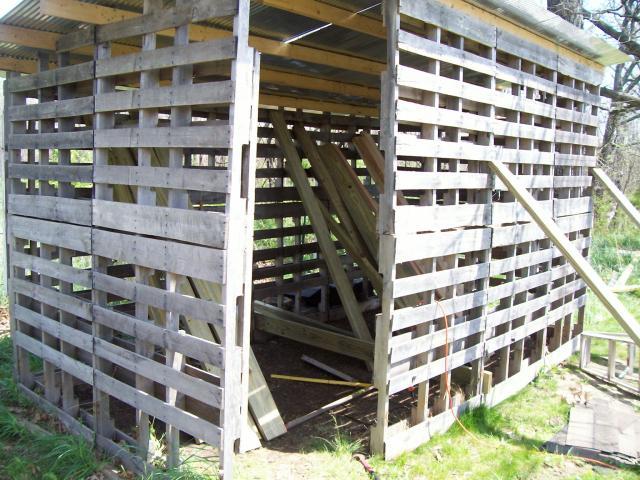

Roof
is 5 - 2x4x20 running from side to side (I used tin. If you're wanting
to cover with plywood and shingle you will want to run 2x4x10's from
front to back). I lowered the back wall to 6' for a slope for roof. I
left the center runners on skids to attach my 2x4x20's.
Floor:
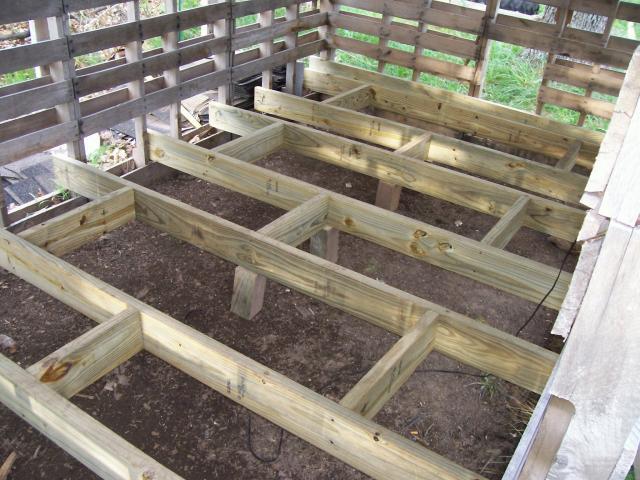 For
the floor I left the bottom wood of skids intact. I cut away the next
horizontal piece of wood above that out. Leave the runners of the skid
in place, this is what you will attach your floor boards to. I then ran
treated 2x6x8 boards across the bottom and attached the the back and
front runners at every 2'.
For
the floor I left the bottom wood of skids intact. I cut away the next
horizontal piece of wood above that out. Leave the runners of the skid
in place, this is what you will attach your floor boards to. I then ran
treated 2x6x8 boards across the bottom and attached the the back and
front runners at every 2'. Make sure they are level when you attach them. Also make sure you have boards at the 8' mark for your floor to attach to. I put 2x6 pieces in between the boards in offset pattern for support and I also put pieces along the entire outer square So i could attach floor to them. I put sections for 4x4 under in spots just for added support.

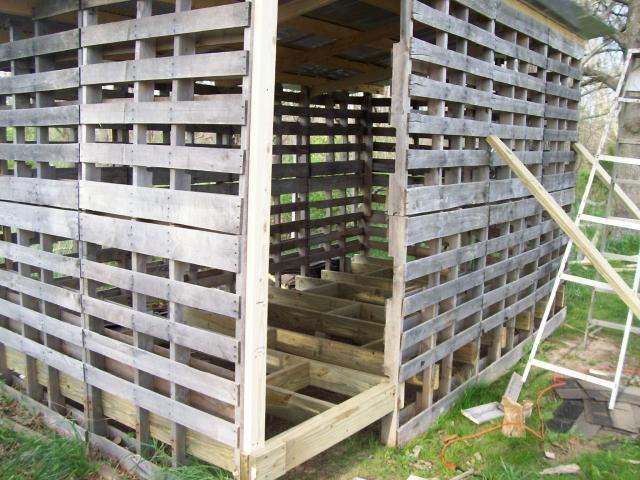
For the floor i used 4x8 3/4" OSB board. This is strictly up to you if you'd rather use plywood. Just lay your boards on top of the 2x6's and screw them on. At this point I also cut out my exit door to the run.
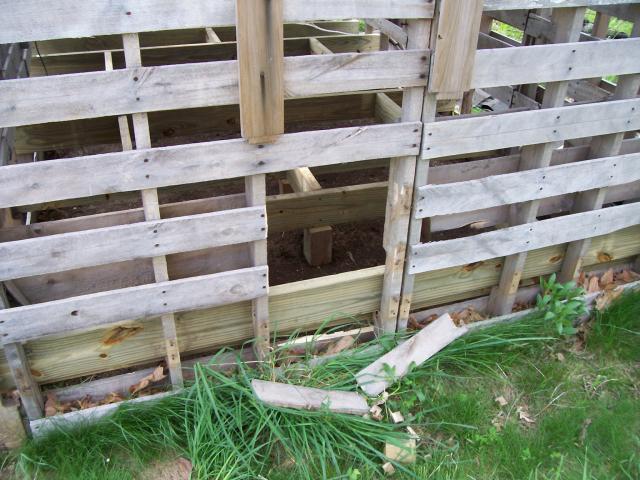
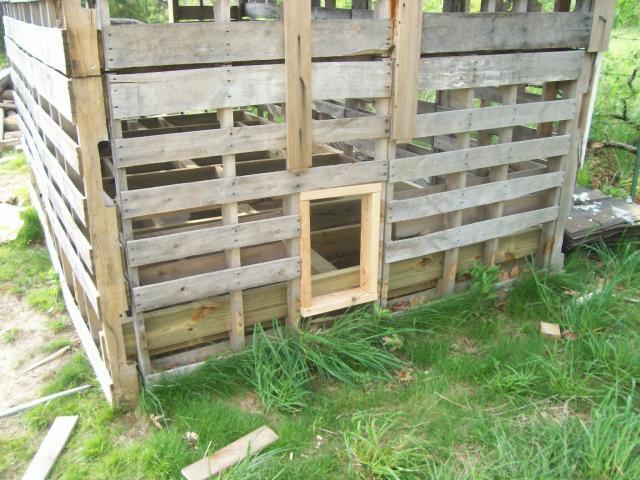
Interior Walls, Windows, Door:
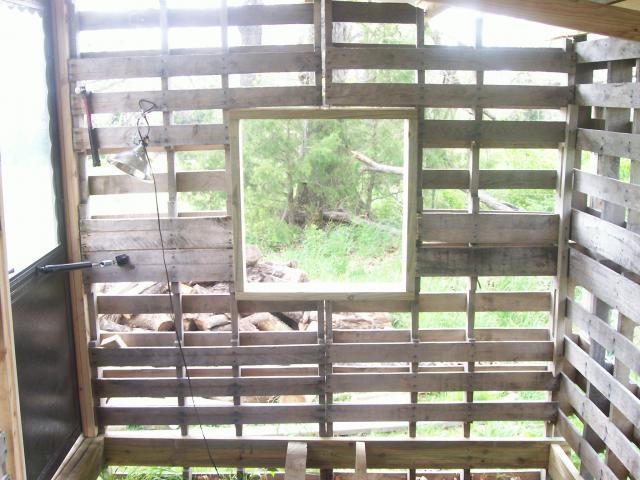
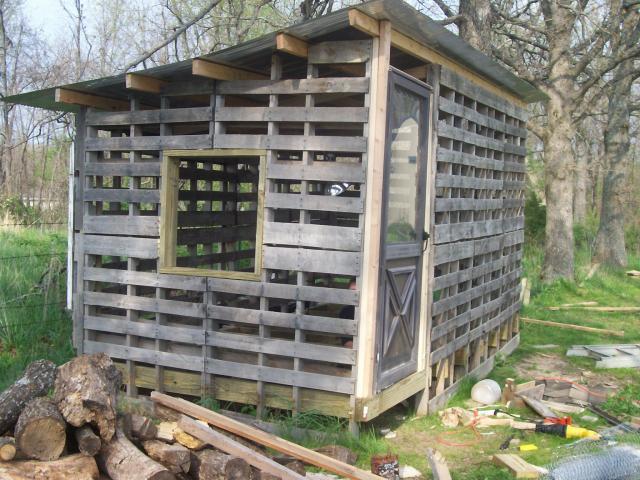
For the interior walls I used 4x8 1/2" OSB. I did front and rear first then side, but either way would be fine. Run any wiring g you may be doing now. I installed 1 light and 1 outlet. Here in our county if you wire to breaker box you have to pay taxes on it, so I used heavy duty extension cord so it can be unplugged if the assessor comes.
Now grab your boards and put them up and screw them on. Leave the upper section of the sides open for ventilation. Now you can paint the color of your choosing.
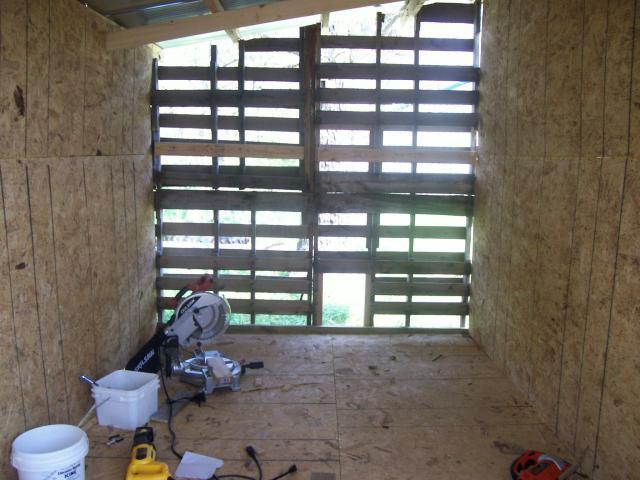
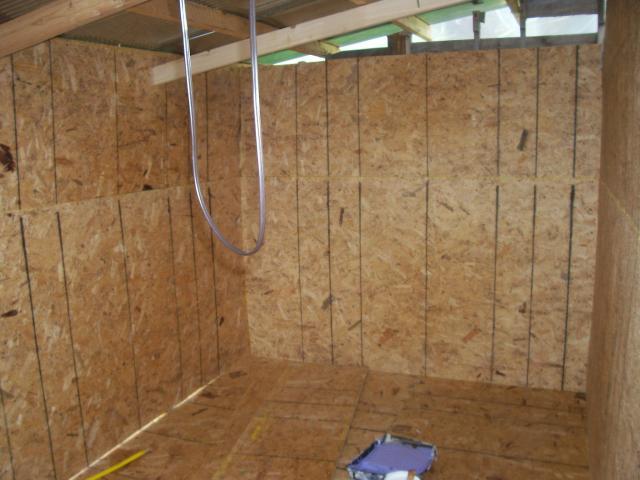


Frame your door making sure all is level and straight. Use 2x4's with shims as needed to get door to open and close flush.
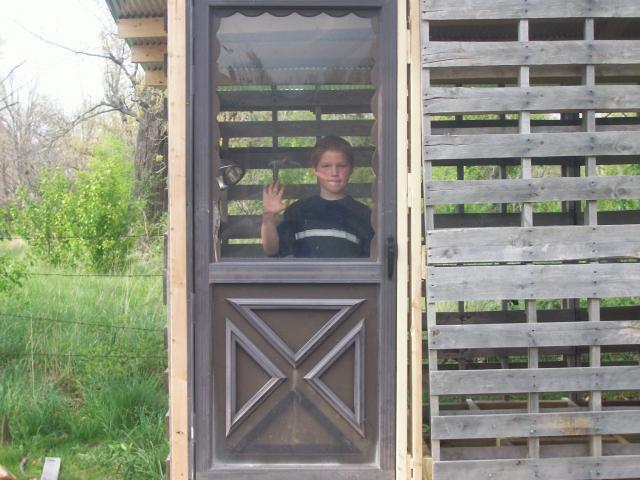
Nesting Boxes:
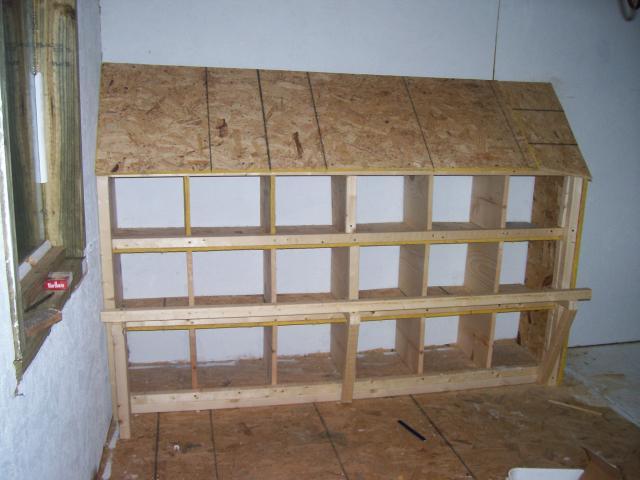 Ok,
I have been told that there are too many boxes here so it's up to you
how many you wish to make. I just put 2x4's down on floor 12" apart. I
made a rectangle with 1 more middle support. On top of this I put my
1/2 osb board. I attached a 2x2 to the front of the boxes. I used 1x12
from dividers cut 12"x12". Screw dividers into the 2x2 and toe screw
into wall in the back. I cut 3 sections of 2x2 for sides and middle for
support of next level. Osb on top of your dividers and repeat
process. For top I attached a 2x4 to the wall and sloped osb roof for
boxes. I used remaining 2x2's to make a small perch between bottom and
top. Done! Paint!
Ok,
I have been told that there are too many boxes here so it's up to you
how many you wish to make. I just put 2x4's down on floor 12" apart. I
made a rectangle with 1 more middle support. On top of this I put my
1/2 osb board. I attached a 2x2 to the front of the boxes. I used 1x12
from dividers cut 12"x12". Screw dividers into the 2x2 and toe screw
into wall in the back. I cut 3 sections of 2x2 for sides and middle for
support of next level. Osb on top of your dividers and repeat
process. For top I attached a 2x4 to the wall and sloped osb roof for
boxes. I used remaining 2x2's to make a small perch between bottom and
top. Done! Paint!
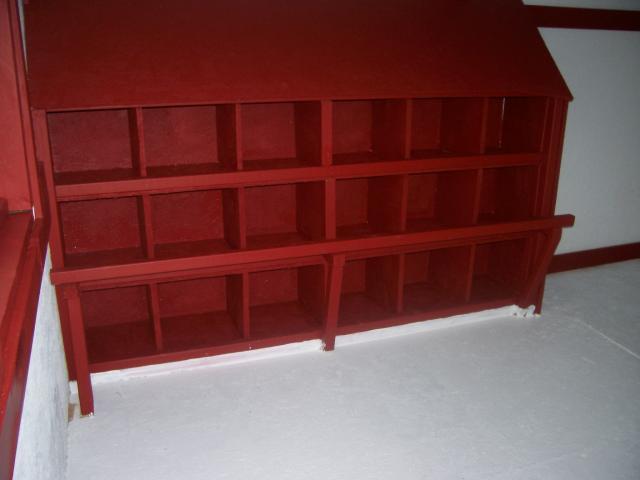
Interior Trim and Roost:

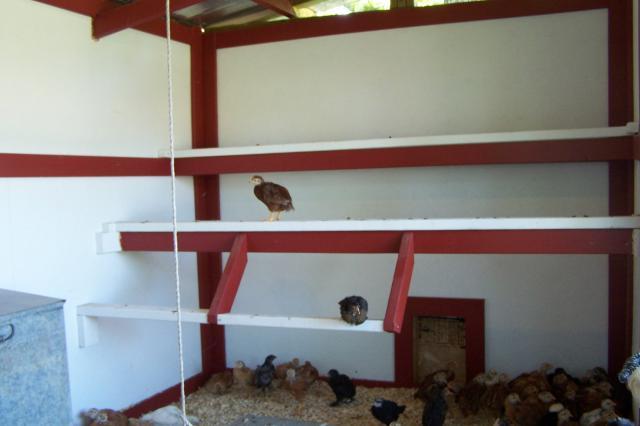
Exterior of coop:
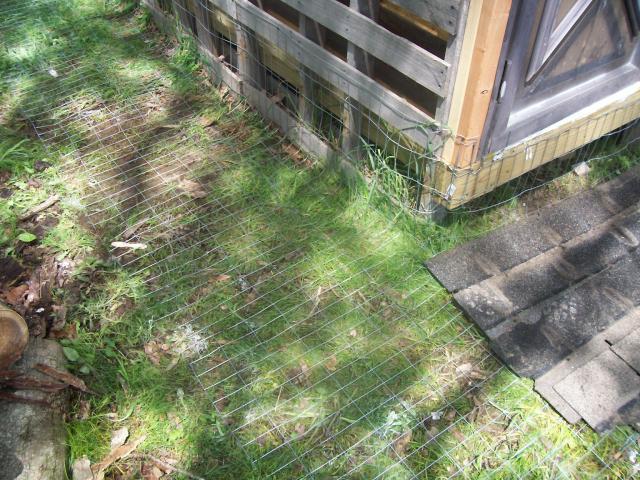
Not completely done, but chicks love it!!

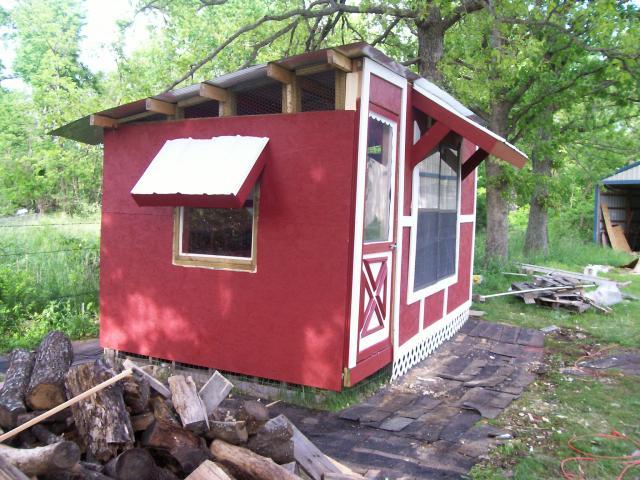
Outside Run:
- 65 = 8' Garden timbers
- 30 = bags of QuickCrete
- 5 = rolls of 36x25 1/2" hardware cloth
- 5 = rolls of 36x50 25 ga welded wire fence
- 3 = 1x6x8 treated for gate
- 1 = gate latch
- 1 = rented auger Home Depot
- 2 = rolls of 7'x100' deer netting
The top, bottom, and middle rails are also 8' garden timbers. Middle set at 36" and top at 6' to fit wire.
Bottom wire is 36" 1/2" hardware cloth. Top is 36" 25 ga welded wire. Outside perimiter of run is aproned with 25ga wire also laid out 3' and covered with roofing shingles to keep weeds down.
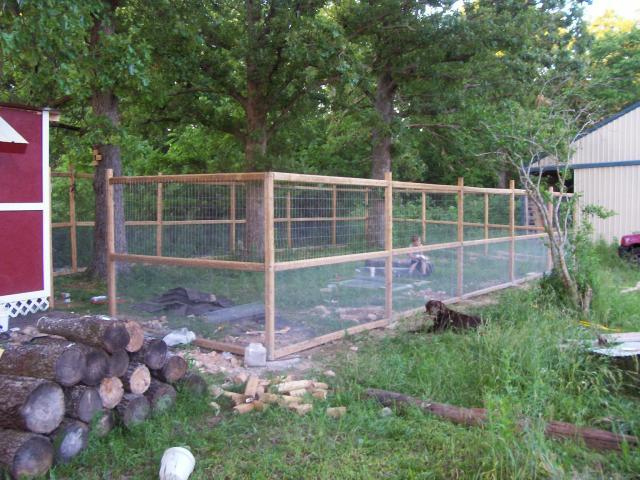

Chicks first day in run. "That's one small step for a chicken, one giant step for the flock".
Gate is made from 1x6x8 treaded lumber cut to height with 3 dividers for support. I covered gate with 1/2" hardware cloth. Latch is a sliding pin latch that locks into a drilled hole in the post. Coop sets on a slight slope so I put another 1x6 at bottom of gate to cover gap.
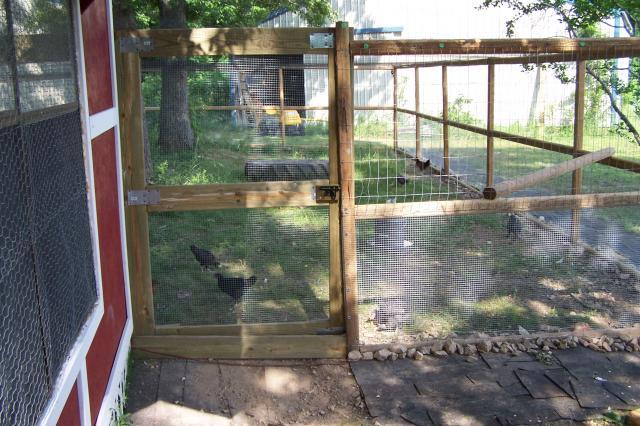
Entire top is covered with deer netting. We do have hawks in or area so better safe than sorry. I used roofing butt tabs to hold netting down. They are nails with a green circle plastic tab on them. They worked great on net. (You can see a few in above pic)

First day in run.

This
design is great for those of us that don't really understand framing
walls, roofs, and other construction aspects of building a coop.
It
also saves you quite a bit of money on lumber costs for you can get
pallets free if you look around.
I tend to go overboard, but you can
easily go with dirt floor, or no interior walls or trim to cut cost.
I
hope other find this helpfull for them to get their project started and
share in the joy of watching their chicks step out into the real world
for the first time.
Jjamerb's Pallet Palace Chicken Coop http://www.backyardchickens.com/a/jjamerbs-pallet-palace-chicken-coop
..
Subscribe to:
Posts (Atom)





